An original Indenture for the London Tavern signed by John Farley the famous cook.
Signed individually by all parties, for “ a new partnership in the trade and business of a Vintner of and in the said House and Tavern called the London Tavern in Bishopsgate Street aforesaid for the Term of Seven Years”.
Two large vellum membranes - 711 x 838mm. Folded in typical indenture folds for filing and storage with top outer part showing in fine ink script, dated 1800 and Farley, Terry and Peacock’s names and their ‘Articles of Co-Partnership’. The exterior fold has some light soiling and browning to one outer edge where its has been stored on a shelf for many years, but internally its very clean. The beginning of the indenture has a large elaborate heading in ink and a good cursive hand is evident throughout the whole manuscript. The signatures of Farley, Terry and Peacock are at the bottom, each with a small red seal. Overall an excellent item.
- John Farley was the well-known Head Cook of the London Tavern whose famous cookery book ‘The London Art of Cookery’ was first published in 1783. When he started and finished his tenure there is hard to establish. We do know that his time at the London Tavern extended for many years, and he played a large role in its fine reputation and success. In The Old Bailey trial accounts for the 16th September 1795, it is recorded that a man, Clark Hillard, was indicted on August the 4th for stealing from the London Tavern. The accusers, named as the directors of the Tavern, were John Bleadon, John Farley, Edward Terry and John Henry Peacock. Five years later John Bleadon has left and the three remaining directors have re-applied for, and been granted this Vintner’s licence on August 8th 1800, for a period of seven years at a cost of £1500.oo per annum. The document further states that the directors were fined £400.oo for letting the licence lapse on the June 29th of the same year. It appears the variance in lapse dates happened because John Bleadon had stepped down as a director. The license also notes that if there is going to be a change in the future Vintners partnership it should be done by the fourth year of its term. In John Timb’s book ‘Club Life of London’ we are informed The London Tavern was re-built on the western side of Bishops-gate Street Within on the site of the former White Lion Tavern, which burned down on November 7th 1765. It was completed by Richard B. Jupp, architect, and opened in September 1768. Taking up a large footprint on the site of the current Royal Bank of Scotland PLC, the Tavern was a huge building, 80ft wide and 70ft tall. It boasted many private dining rooms and a very large public room; the Great Dining Room or 'Pillar Room', measuring 40x33 feet. On the floor above was the Ballroom measuring 33 feet in width and extending the whole length of the building. This room could also be converted to a banqueting room that would hold 300 dining guests. The room also had two galleries at each end to allow 150 ladies as spectators. An unusual concept!? After doing further research I could not find any other facts that confirmed this was a common setup in other eating establishments. This strengthens though, the fact that dining out in Taverns and Clubs was the domain of men only. (This setup would only be truly broken when Cesar Ritz designed and run his famous Hotels in the latter part of the nineteenth century for the exclusive comfort of women, in the sure and very astute understanding that when the women came to dine, the men would follow, with the inevitable desire to book rooms as well.) Not only did the London Tavern have many floors, it also had many levels in its basement, which even stretched under the adjoining buildings on both sides. One of basement floors had a number of huge vats installed, that each held two tons of live Turtles. We are further informed that if the Turtles are kept in the same water as they were shipped in they will survive very well for 3 months. To change the water would lessen the weight and flavour of the animal. This beautifully written Vintners license covered a huge cellar. Timb’s description states that the cellar covered one huge basement storey, filled with barrels of Porter, pipes of Port, butts of Sherry etc. There were labyrinth walls of bottles and a huge region of bins, six bottles deep; described as the catacombs of Johannisberg, Tokay and Burgandy. Also in storage, 1200 Champagne, 700 Claret and thousands of genial wines. We are informed those wines also absorb an interest of 5% per annum. All over this vast wine store Timb’s quaintly describes “floors with rivers of sawdust”. The final chapter in the story of The London Tavern happened around 1910 when it was demolished. After 142 years of being one of the most famous and prestigious grand City restaurants, its name was appropriated by the proprietors of the nearby King's Head Tavern in Fenchurch St. Finally, this exceptionally rare, large Indenture is a fantastic piece of ephemera, not only because of John Farley’s rare signature, but as a glimpse of what a serious and expensive business it was to be granted and hold a Vintners license in eighteenth century England.
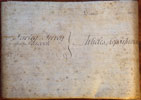
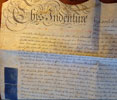
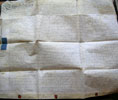
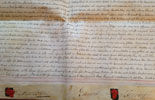
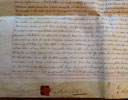
click on image to enlarge

Antiquarian category
ref number:
11217